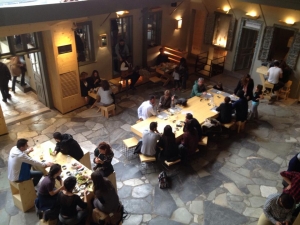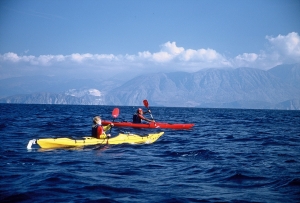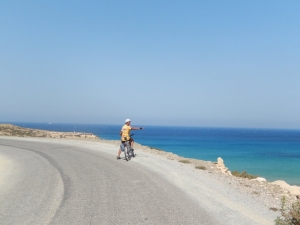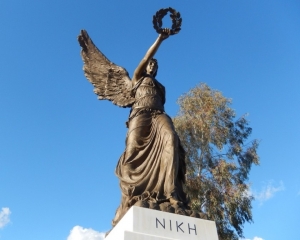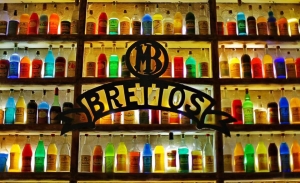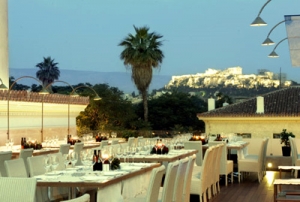LIFE & CULTURE
XpatAthens
Curry At The Port
After the snow (what?!) and cold temperatures of last week, it’s almost impossible to recall the sunny, balmy 18-degree days of last weekend. I had planned a fun-filled afternoon with a friend who promised to show me around Piraeus – a part of the city, I must admit, I do not frequent. Not for any particular reason, apart from not really knowing much more about Piraeus than the passenger port for trips to the islands…
We met at Piraeus station, and made our way on foot around the port area, on a long walk around the ‘peninsula’ that is Piraeus proper. The seaside walk was beautiful, and we stopped along the way at the endless strip of taverans and cafés of Akti Themistokleous for a coffee and maybe even a tsipouro or two… The seaside views and beachside walk was wonderful – and totally doable on foot over a couple of hours. We made it as far around as Marina Zeas, but called it a day since we were by then starving…
We decided to go nuts and go for Indian food. My friend has been trying to get me to her ‘local Indian’ for ages – so we went. The place is called Kebab & Curry – and it lived up to its praise. It’s an unassuming space, simple, run by an Indian family. ‘Taki’ the owner had saved us a table, and my friend had phoned ahead to arrange a fixed-price feast. This was wonderful – no need to look at the menu, no need to deliberate, just eat and enjoy! The food here is great – authentic, spiced according to your preference, and evidently quite popular. There was even a delivery bike outside for lucky Piraeus locals.
All in all a nice afternoon in an under-rated part of the city. Next time we will walk the opposite way around and stop in Mikrolimano and the endless fish tavernas – a popular city highlight for locals and visitors alike!
Kebab & Curry
Skouze 14, Piraeus
210 428 5937
Until next week,
Jack
In this weekly space, keep up with ‘Jack’ as he navigates daily life in Athens… Anecdotes, stories, hits & misses, the good, the bad and, well, the rest…
Culture + Cool
Those of you who know the Thiseio neighbourhood may have wondered lately what happened to the old Stavlos bar at the top end of Iraklidon street. It had been a neighborhood staple for years, but lately lost some of its popularity – and over the past months was closed down completely. The space has since been completely gutted and transformed into a wide-open, airy, multi-function space called Root Artspace.
I went by accident on Sunday afternoon – the open door and warm noise coming out of the small door made me wonder what was going on inside… There was plenty going on!
The original building dates from 1845 when it housed the horse stables of King Otto. It later became a prison, and then a school, until the late 1980’s when it as transformed into the well-loved Stavlos bar. (This seems to be a not-so-unusual story for some of Greece’s historic properties – don’t they all become a bar at some point??)
On my unplanned Sunday visit, the place was buzzing with activity. A few questions to the barista got me some interesting answers about the Root Artspace concept.
This place has a grand vision. The venue will host performances, exhibitions and festivals. The restaurant offers up an urban street food menu based around organic and ‘paleo’ principals. The bar – called a ‘wellness bar’ – offers a range of healthy cocktails, some even sugar-free and gluten-free. And there is an actual record store (of the vinyl type) inside the space. The day I went they had a live band playing jazzy/blues music. And the service was very friendly (warm smiles and thank-yous all around).
This is seriously forward-looking stuff for Athens.
I have to say that this may be my new favourite place. The multi-room space itself is more than cool – it’s incredible. The menu and drink list is unique in the city. The music is eclectic. Good service, great vibe. With enough creativity to make it seriously interesting. And enough ‘urban attitude’ to make it very Athenian indeed.
Root Artspace
Iraklidon 10, Thiseio
+30 210 345 0003
www.rootartspace.gr
Until next week,
Jack
In this weekly space, keep up with ‘Jack’ as he navigates daily life in Athens… Anecdotes, stories, hits & misses, the good, the bad and, well, the rest…
Sea Kayaking In Spinalonga Bay
Standing on the seashore of Plaka, a hamlet 16 kilometers north of Agio Nikolaos in eastern Crete, the island of Spinalonga looks invitingly close. Just a hop, skip and a jump away by sea kayak—or so it seemed. Spinalonga is a spit of land situated at the mouth of Spinalonga Bay.
Strategic since antiquity, in 1579 the Venetians erected a gargantuan fortress befitting of their superpower status, and indeed, its protectors defied Turkish conquest for several decades longer than any other Cretan garrison. The fort finally fell to Ottoman rule in 1715.
On a warm October day our cozy group of four Americans and four Greeks planned to kayak over to Spinalonga Island. From there, we would head down its bay, a short portage, then down Poros Bay to Agio Nikolaos. At most, the trip was fifteen kilometers.
From Plaka, a local fisherman can probably make the voyage to Spinalonga Island in about twenty minutes. It took my best friend Pia and me about two hours.
Pia and I had never kayaked. Our initial hour was spent on land just trying to get a grasp of this sport and its paraphernalia. We donned life jackets, colorful wetsuits and learned how to put on a “kayak skirt.” This is a sturdy cloth worn around your waist: when seated in your kayak, you attach the skirt’s hem to the open perimeter of your seat so that water doesn’t enter the boat. Next were some rudimentary rowing lessons. We sat on the beach, pretending we were at sea, and went through the motions of manipulating the paddles.
Pia and I reasoned that, being first-time kayakers, we should operate the two-seater. Wrong. We didn’t know when to paddle, how to coordinate our rowing or even which direction to face when a strong wind blew. Not but fifteen minutes after setting out to sea, one moment we were dry, the next moment we were wet. The boat capsized so suddenly we didn’t even have a chance to shout the proverbial “Man Overboard!” Sobered by the incident, we took our friends’ advice and got our own kayaks, and discovered that individual navigation was superior to teamwork, at least when the team was clueless in the art of kayaking.
When we arrived to Spinalonga Island some of us were quite wet and all of us looked a little goofy in our loudly colored kayak mini-skirts. The tourists stared, mostly at Miltos. While our skirts laid flat, his undulated with a flamboyant pink hem akin to an Argentine tango costume that got shrunk at the cleaners. For some reason, he kept it on during our entire visit to Spinalonga which prompted endless guffawing.
After Crete formally united with Greece in 1913, Spinalonga became a leper colony and remained so until 1957. The island is larger than expected when you peer at it from the Crete mainland. One can easily spend several hours strolling its pathways and perimeters. The elegant Venetian architecture—curved arched portals, for example—contributes to Spinalonga’s beauty, yet a haunting feeling pervades,perhaps attributable to the cemetery whose open graves bear the assumingly impaired bones of the prior inhabitants.
My afternoon kayaking was far more successful once I got the hang of it. And the disappearance of the winds helped appreciably. Our group soared along pretty much all together instead of scattered leagues apart as we had been during the morning. The scenery in Spinalonga Bay is breathtakingly spectacular -- mountains in the distance on a blinding shiny blue sea devoid of any other seafarers except the eight of us. The rock cliffs on the coast mesmerized me: they were wavy, in layers, like slabs of thick uncooked bacon stacked on top of one another, truly of postcard caliber. One area we paddled to was peculiar as it felt sheltered like inside a cave but actually we were in an open area on the sea.
If you are inclined towards a little physical activity while vacationing, I heartily recommend sea kayaking in Spinalonga Bay. Beginners can complete the journey from Plaka to Agio Nikalao, with a pit stop on the island, easily in one day. By the end of your adventure, you will feel exhilarated by the aquatic workout and gain yet another reason to place Crete high on your list of magnificent Mediterranean islands.
By Colleen McGuire
Managing Director of cyclegreece.gr
Cycling On The Island Of Gavdos
Where is the most southern chunk of real estate in all Europe? Not Rhodes or Malta or Crete, and certainly not Sicily. To stand on the farthest south land in Europe you must make your way to the island of Gavdos, 170 nautical miles from Africa to the north and 22 nautical miles south of Crete’s feistiest region, Sfakia. “Oh my, it’s hot.” Those were my first words when I got off the boat.
Admittedly, we landed at one in the afternoon, but still, I had just spent several days cycling from morning to dusk in Crete, so even though I was accustomed to a mid-day sun, Gavdos was of another order.
The island is only ten kilometers long and five kilometers wide which makes it bikeable in its entirety in less than a day. The heat and hills probably account for why I didn’t see a single biker during my brief three-day sojourn. Many people walk where they need to go on the well maintained network of paths.
As of September 2014, Gavdos has no hotels, no banks, no ATMs, no post office, no nightclubs, no full time resident doctors. There is a heliport. There is one policeman for the 100 or so residents. I heard his car siren blare when he picked up his daughter from school. In the 1930s Communist political prisoners were exiled to Gavdos.
I stayed at Sarakinika, the beautiful beach settlement (it can’t possibly qualify as a village) where visitors can rent a smattering of rooms and eat in about a half dozen tavernas, some with wi-fi. Most folks like myself camped in tents in the coastal dunes amidst the pines trees and Juniperus shrubs less than a minute’s walk to the sea. I bathed in a rigged up shower on the beach with no curtains but no matter because nudity doesn’t raise eyebrows. My second shot at bathing was a bust because there was no water in Sarakinika which I’m told happens regularly.
As you may have guessed, many of the residents are hippies in retreat. I met Vasilis whose tall frame and long narrow beard evoked what I imagine Pythagoras to have looked like. Vasilis has lived on Gavdos in a tent for fifteen months. I guess he has had a full social calendar because he hasn’t even made it to Trypiti yet, which was the highlight of my visit. I met Antonio from Portugal who epitomized the permanent nomad with his tattoo sleeve and plugs in both ears the size of a one euro coin. His purpose in life seemed to be moving from one outdoor summer music festival to the next.

I wanted to sit on The Throne in Trypiti. This beach is the most southern point on Gavdos island. Where the gravel road stops is a path that takes thirty minutes walk downhill to reach Trypiti. At the beach’s most southern tip is a giant chair that faces north towards Europe. The local Russians built the chair and made the path. Their small community began with a nuclear physicist fleeing Chernobyl. They are scientifically attuned to ecological ways to live and they trade their skills for food and other needs. The locals appreciate them and their presence adds to the mystique and allure of Gavdos.
You’ve really got to have a low footprint to visit Gavdos. This is not a place for those expecting mints on their pillow, a pile of ice cubes for your ouzo or to buy a new pair of sunglasses. Gavdos is raw. It is a place where the nymph Kalypso is said to have imprisoned the shipwrecked Odysseus holding him as her lover. I suspect Gavdos has had its share of modern-day Kalypso and Odysseus wannabes.
By Colleen McGuire
Managing Director of cyclegreece.gr
Biking The Magnificent Marathon Region
On a recent sunny Sunday in December, my partner and I went cycling in the Marathon region northeast of Athens. The beauty of the ride is that it combines amazing history with a bike route capable for any reasonably fit rider. We parked the car at the conveniently located Schinias Rowing Center which is open from dawn to dusk and equipped with washroom facilities. The place was lively with kayakers plying the lake waters and runners racing to the finish line of a competition in progress.
Our biking itinerary made a giant loop totaling 30 kilometers. The excursion took two hours of actual cycling but lasted four to five hours because we were compelled to stop and explore the marvelous points of interest, as well as, eat lunch at a seaside fish taverna.
The first antiquity we came upon was the Nike Trophy, a reconstructed marble obelisk located near the spot where in 490 B.C. the Athenians amazingly defeated the Persians even though outnumbered three to one. (Nike means “victory” in Greek). In contrast to trophies in battles between the Greek city-states in which the armor of the defeated was hung on a tree trunk, the trophies of the Persian Wars were grandiose monuments.

The bike route runs through an agricultural area entirely flat and minimally trafficked. We pedaled past fields of cabbage big as basketballs and broccoli with sprawling leaves fit for a rain forest. We saw fire engine red tomatoes, orange orchards and vineyards looking forlorn with grapes no longer adorning their vines. Farmers sold fresh produce at colorful roadside vegetable stands.
Eventually we arrived at the grassy enclosure of the Marathon Tomb (entry fee three euros). The Greek soldiers’ burial had been lost to history until 1890 when it was rediscovered, excavated and now rises as a swollen green mound (“soros”). This is the precise spot where 10,000 Athenians and 1000 allies from Plateia in central Greece defeated the mightiest super power of the day, the 30,000 “immortals” of the Persian army who prior thereto had only once before been vanquished in war. The battle lasted an hour and resulted in the deaths of 6400 Persians and only 192 Greeks. The enormous confidence enveloping the Athenians by their colossal victory gave them the greatness necessary to create all the extraordinary elements by which they gave birth to Western Civilization.
From the Tomb it is a quick fifteen minute ride further inland to the Archaeology Museum of Marathon. One usually thinks of museums in an urban setting but this one is located in an isolated rural environment where tranquility reigns. The prize of the museum is the original Ionic capital of the Nike Trophy. Also exhibited in the small building are pottery from the Cave of Pan and impressive four meter high “kouros” statues from a nearby Egyptian sanctuary. The remnants of that ancient sanctuary lie along the coast in Nea Makri and that is the next destination we biked to upon leaving the museum.
It was glorious to reach the Aegean Sea and bike along the wide coastal walkway that stretched from Nea Makri to Marathon’s sea front about eight kilometers away. En route you could glimpse the Egyptian sanctuary through a locked gate but there were only archaic foundations, no marble statuary. Next to it lie the ruins of a 3rd century AD villa built for the Roman Herodus Atticus, but also inaccessibly gated. Families and couples were strolling along the sidewalk, some jogging, a few brave souls swimming and many feasting at the outdoor tavernas with front row seats to the sea.
We finally made it back to the Schinias Rowing Center but there was still light in the day and we had not exhausted ourselves. So we continued eastward to the Schinias National Park, a rare aquatic ecosystem in Attika consisting of thirteen square kilometers of springs, swamps, streams, a lake and pine forested beach front. We climbed the tall ranger tower to admire the magnificent view of the sea and mountains in the distance; here birdwatchers seek a glimpse of over one hundred species inhabiting the park, along with foxes, badgers, hedgehogs, rabbits, reptiles, turtles and frogs. Biking on dirt paths in the wetlands, not a soul in sight, at times it honestly felt like we were hundreds of miles from civilization, be it modern or ancient.
By Colleen McGuire
Managing Director of cyclegreece.gr
Europe's Second Oldest Bar Is In Athens
Brettos (pronounced Vrettos in Greek) is said to be Europe's second oldest bar and is the oldest distillery in Plaka with over 100 years of operation. Brettos offers unique tasting experiences, a friendly environment, and unrivalled service in a beautiful, dramatic setting.
Although it's tucked away, Brettos is one of the most photographed locations in the city – you won't miss the hundreds of colorful glass liquer bottles and lights that decorate its walls.
As one of the oldest distilleries in Athens, Brettos began operating in 1909 at the ground level of an Athenian mansion. Using old family recipes from Smyrni, the founder Michael Brettos started producing ouzo, brandy and a few liqueur flavours based on all-time classics like cherry and peppermint as well as distinctive Greek flavors like citrus and mastiha. When demand began to rise, he relocated the distillery but continued to operate the small shop on Kydathineon Street as a liquor shop and bar where locals and guests alike could taste and buy Brettos' renowned liqueurs.
Very little has changed since 1909 at Brettos' old distillery, and it still operates as a bar in a small and charming corner of historic Athens. It is still serving visitors ouzo, brandy, more than 25 different kinds of liqueurs–none of which are available in liquor or grocery stores; Brettos also serves traditional Greek spirits, wines and beers.
Brettos is open daily from 10 am till 2 am and is as much a historic landmark frequented by tourists as it is an age-old hang out for locals and an ideal place for a nightcap!
Address: 41 Kidathineon 41, Plaka-Athens
Telephone: 210 3232110
We Love El Taco Bueno!
El Taco Bueno is one of the best Mexican restaurants in Athens. It has three restaurants in Chalandri, a northern suburb of Athens. You’ll find that it is simply decorated with hints of Mexican culture, from the checkered tablecloths to the sombreros and Mexican wool rugs hanging on the walls; all of which bring you closer to the Mexican mentality and temperament. Once there, you’ll enjoy simple, fresh Mexican food while sipping on their famous margaritas and sangria.
El Taco Bueno
All of the food at this restaurant is superb but here is a small taste of what you’ll find.
After you are seated, you are quickly served with a little bowl of nachos and salsa dip and a large glass of water to get your appetite going while you glance over the menu.
For starters, you can order nachos topped with melted cheese or chili (or both!), Mexi Cali Fries, Jalapeno Poppers, onion rings, chili con carne and quesadillas, not to mention some of the best buffalo chicken wings to be had in Athens. Their salads, which include the bueno tostada and the Mexicana salad, both set in a scrumptious tortilla shell, are fantastic; they are enormous and tasty.
For the main course, you can choose their specialty, fajitas, which are both delicious and in such large quantities that you will definitely want to share with friends! You can also try their enchiladas, chimichangas and burritos as well as hard taco shells filled with the meat of your choice, including minced meat, chicken or beef. But if you get stuck on what to order, don’t hesitate to ask the staff for suggestions – they are more than happy to help!
The service is excellent and in the summer, you can enjoy your meal in the garden, surrounded by trees and colorful flowers.
Don’t forget to make a reservation – although the restaurants are fairly large, the tables quickly get booked up!
Note: Most of the above dishes can be made meat-free for vegetarians.
WHERE:
El taco bueno
Ethinikis Antistaseos & Psaron 1, Chalandri
Tel 210 6840460
El taco bueno autentico
Aristotelous 84, Chalandri
Tel 210 6813787
El taco bueno delivery
Pentelis Ave. 12-14, Chalandri
Tel 210 6800662-3
OPENING HOURS:
Tuesday-Saturday 19:00-24:00
Sunday 13:00-24:00
Average cost per person: 20-25€
Do you have a recommendation or recipe to share? Send it to us at ideas@xpatathens.com!
Ninnolo - The Home Of Great Gelato
We tried Ninnolo's heavenly ice cream last week and definitely recommend it highly! Whether you're in Kifisia or Agia Paraskevi, head to Ninnolo's for a taste of their homemade gelato - you'll definitely go back again and again. We tried the chocolate, pistachio and pink grapefruit - cant wait to try the rest of the flavours!
Locations:
Kifissia: Agiou Dimitriou 8 - Tel: 21 0801 2765 (around the corner from the AB Vasilopoulos super market on the main street)
Agia Paraskevi: Evergetou Giavasi 13a, 15342 - Tel: 213 0 240 776 - Email: ninnolo.gelato@gmail.com
They are also open for breakfast and brunch.
For further info, visit their Facebook pages here and here.
Do you have a recommendation or recipe to share? Send it to us at ideas@xpatathens.com!
Varoulko 'Athens' Finest Seafood Restaurant'
Seafood legend Lefteris Lazarou won the Michelin race, gaining the country’s first star for Greek food—and rightly so, say the hordes clamoring for tables at this wood-floored, white-walled dining room (belonging to Hotel Eridanus) or a prized one on the terrace overlooking the Acropolis. Lazarou rises before dawn to source his psari (baked seafood dishes) and treats them in ways that veer into classical French territory without ever leaving Greece. Typical are cuttlefish risotto with caramelized garlic and bay leaf, and grouper with wild greens braised in egg-lemon sauce. Meat dishes are fewer, but just as amazing, such as his take on patsa, the workingman’s tripe soup, served in a martini glass.
Dinner for 2 from about 120€, fish priced by the kilo
80 Piraeus, Athens
210/522-8400
www.varoulko.gr
Do you have a recommendation or recipe to share? Send it to us at ideas@xpatathens.com!
A Hidden Restaurant In Gazi With No Name
Babis, the chef/owner says that during World War II people would go down there for shelter, good food and wine. The taverna upstairs often featured a famous singer, and a lady would play piano, which you could hear downstairs. Babis specializes in Byzantine style food of which the Politiki Salata (salad of The City/aka Constantinople) is a sublime mix of aubergine, garlic, olive oil and sour cream however it is advisable to try absolutely everything. There is no real menu, however dishes that feature include slow roasted baby lamb cooked en parchment, meatballs with stewed scallions & artichoke hearts, mashed fava beans with diced red onions, lemon juice, olive oil, and capers, a tostada-type of treat with ground seasoned meat on one half and aubergine, tomato, and a mild white cheese on the other. They only serve barrel wines but you really shouldn't be drinking anything bottled with food like this; get it by the kilo. The whole meal is so cheap it will blow your mind. So, if you can find it and manage to get a table, seek out the secret taverna that has no name but doesn’t seem to need one.
Do you have a recommendation or recipe to share? Send it to us at ideas@xpatathens.com!


